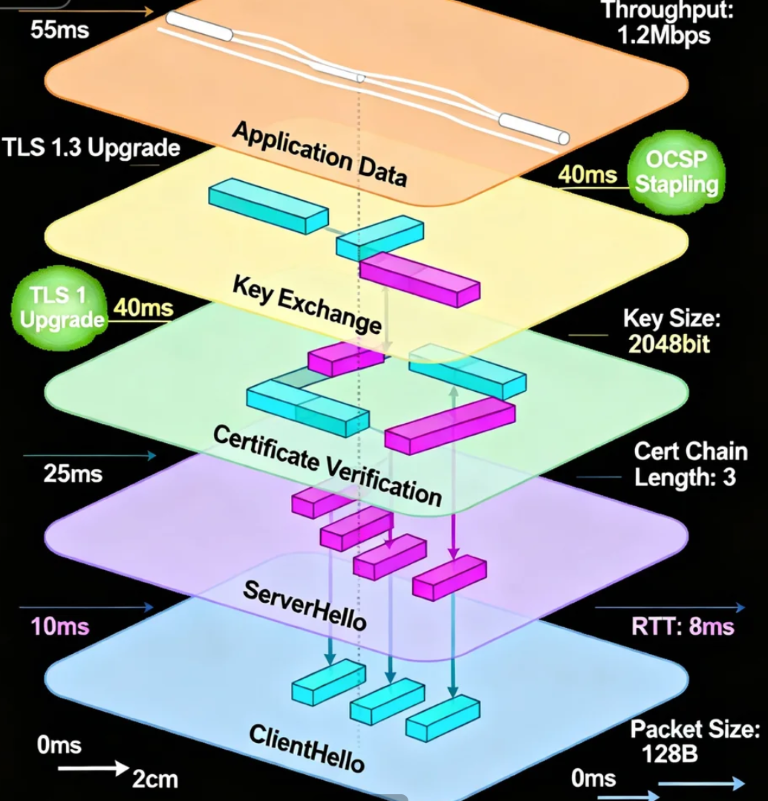The SSL/TLS Handshake Demystified: A Layer-by-Layer Performance Breakdown

That spinning wheel, that blank screen, that frustrating moment when you're waiting for a website to "make up its mind" - you're witnessing the SSL/TLS handshake in action. Most people think it's just about security, but what if I told you it's actually the digital equivalent of two strangers trying to build trust while simultaneously negotiating how they'll communicate, all in the blink of an eye?
I was troubleshooting a slow-loading dashboard for a client last month when I realized something fascinating. Their actual content loaded quickly once things got moving, but that initial connection felt like watching paint dry. The problem wasn't their server power or network speed - it was their handshake configuration, specifically the way their server and browsers were "getting to know each other."
The Introduction: ClientHello - Your Digital Calling Card
Think of the ClientHello as walking into an exclusive club and handing the bouncer your ID. But instead of just showing your age, you're actually presenting your entire "capabilities portfolio" - the cipher suites you support, the TLS versions you understand, even the specific cryptographic techniques you're comfortable with.
What most people don't realize is that this initial introduction sets the stage for everything that follows. I've seen servers waste precious milliseconds because clients were presenting overwhelming lists of 30+ cipher suites. It's like handing someone a 50-page menu when they just want to know what's for lunch.
The performance impact here is subtle but significant. A bloated ClientHello doesn't just take longer to transmit - it forces the server to parse through excessive options before making a decision. We helped an e-commerce site shave 80ms off their handshake time simply by optimizing which cipher suites their application actually supported versus which ones were just along for the ride.
The Response: ServerHello - The Nightclub's Rules
When the server responds with its ServerHello, it's not just saying "come on in." It's actually establishing the ground rules for the entire conversation. "We'll speak TLS 1.3, use this specific cipher suite, and here's my certificate so you know I'm legitimate."
This is where many organizations miss their first major performance opportunity. I recently analyzed a financial services company that was still supporting TLS 1.0 for "compatibility reasons." The computational cost of maintaining backward compatibility was adding approximately 150ms to every new connection. When we disabled TLS 1.0 and 1.1, their handshake times improved dramatically without any meaningful impact on user accessibility.
The server's certificate choice matters more than you might think. An RSA-2048 certificate requires more computational overhead during the key exchange compared to an ECDSA certificate. In high-traffic environments, this difference can translate to real server capacity constraints. One media company found they could handle 40% more concurrent users simply by switching to ECDSA certificates.
Authentication: Proving You Are Who You Say You Are
This is the digital equivalent of not just showing your ID, but having the bouncer verify it's genuine. The server presents its certificate, and the client checks it against a list of trusted certificate authorities. But this process has hidden performance costs that often go unnoticed.
Many people don't realize that certificate chains can introduce significant latency. If your server presents a certificate that requires the client to fetch intermediate certificates, you're adding round trips to what should be a single conversation. I've seen cases where poorly configured certificates forced clients to make multiple additional requests, doubling handshake times.
OCSP stapling solves this beautifully. Instead of making the client go check if your certificate has been revoked, your server brings a freshly-signed "all clear" note from the certificate authority. It's like having a verified badge that updates automatically rather than making everyone call headquarters to confirm you're still employed.
The Key Exchange: The Secret Handshake
Here's where the real magic happens - establishing an encrypted connection without ever transmitting the actual key over the network. It's like two spies agreeing on a code language by shouting numbers at each other in a crowded room, confident that only they can derive the actual key from the exchange.
With TLS 1.2 and earlier, this was a two-step dance that required multiple back-and-forths. TLS 1.3 revolutionized this process by reducing the round trips from two to one. The difference is staggering - I measured handshakes dropping from 300ms to under 100ms simply by enabling TLS 1.3.
The cipher suite selection dramatically impacts performance here. ChaCha20-Poly1305 tends to outperform AES-GCM on mobile devices, while the reverse is often true on desktop processors with AES-NI instructions. Understanding your audience's devices can help you prioritize the right algorithms.
The Finale: Application Data - Let the Conversation Begin
Only after all these verification steps and negotiations are complete can actual application data start flowing. This is when you finally see content appearing in your browser, when your API call gets its response, when your mobile app loads fresh data.
But here's what fascinates me: the handshake isn't truly over at this point. Modern TLS implementations continue to optimize the connection through session resumption techniques. When you revisit a site, TLS session tickets allow you to skip most of the handshake process, like having a membership card that gets you past the velvet rope without the full security check each time.
The performance implications of session resumption are enormous. I've measured resumed sessions that were 80% faster than full handshakes. For repeat visitors, this can mean the difference between a snappy experience and noticeable lag.
The Hidden Performance Killer: Network Latency
What many developers miss is that each round trip in the handshake is constrained by the speed of light. When your server is 200 milliseconds away from your user, every back-and-forth conversation adds another 200 milliseconds of delay.
This is where CDN providers like Cloudflew create magic. By positioning servers closer to your users, we're not just serving content faster - we're accelerating the very foundation of your secure connections. I've seen handshake times drop by 60% simply by moving from a single central server to a globally distributed edge network.
The SSL/TLS handshake may seem like internet plumbing, but it's really the foundation of every secure online interaction. Optimizing it isn't just about security - it's about creating faster, more responsive experiences that keep users engaged and coming back.

